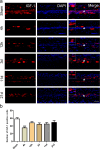Insulin-Like Growth Factor-1 Enhances Motoneuron Survival and Inhibits Neuroinflammation After Spinal Cord Transection in Zebrafish
- PMID: 33481118
- PMCID: PMC11421745
- DOI: 10.1007/s10571-020-01022-x
Insulin-Like Growth Factor-1 Enhances Motoneuron Survival and Inhibits Neuroinflammation After Spinal Cord Transection in Zebrafish
Abstract
Insulin-like growth factor-1 (IGF-1) is a neurotrophic factor produced locally in the central nervous system which can promote axonal regeneration, protect motoneurons, and inhibit neuroinflammation. In this study, we used the zebrafish spinal transection model to investigate whether IGF-1 plays an important role in the recovery of motor function. Unlike mammals, zebrafish can regenerate axons and restore mobility in remarkably short period after spinal cord transection. Quantitative real-time PCR and immunofluorescence showed decreased IGF-1 expression in the lesion site. Double immunostaining for IGF-1 and Islet-1 (motoneuron marker)/GFAP (astrocyte marker)/Iba-1 (microglia marker) showed that IGF-1 was mainly expressed in motoneurons and was surrounded by astrocyte and microglia. Following administration of IGF-1 morpholino at the lesion site of spinal-transected zebrafish, swimming test showed retarded recovery of mobility, the number of motoneurons was reduced, and increased immunofluorescence density of microglia was caused. Our data suggested that IGF-1 enhances motoneuron survival and inhibits neuroinflammation after spinal cord transection in zebrafish, which suggested that IGF-1 might be involved in the motor recovery.
Keywords: Insulin-like growth factor-1; Motoneuron; Neuroinflammation; Spinal cord transection; Zebrafish.
© 2021. The Author(s), under exclusive licence to Springer Science+Business Media, LLC part of Springer Nature.
Conflict of interest statement
The authors declare that they have no conflict of interest.
Figures









Similar articles
-
Semaphorin4D promotes axon regrowth and swimming ability during recovery following zebrafish spinal cord injury.Neuroscience. 2017 May 20;351:36-46. doi: 10.1016/j.neuroscience.2017.03.030. Epub 2017 Mar 25. Neuroscience. 2017. PMID: 28347780
-
Expression of insulin-like growth factors and corresponding binding proteins (IGFBP 1-6) in rat spinal cord and peripheral nerve after axonal injuries.J Comp Neurol. 1998 Oct 12;400(1):57-72. J Comp Neurol. 1998. PMID: 9762866
-
The cell neural adhesion molecule contactin-2 (TAG-1) is beneficial for functional recovery after spinal cord injury in adult zebrafish.PLoS One. 2012;7(12):e52376. doi: 10.1371/journal.pone.0052376. Epub 2012 Dec 21. PLoS One. 2012. PMID: 23285014 Free PMC article.
-
Transplants and neurotrophic factors increase regeneration and recovery of function after spinal cord injury.Prog Brain Res. 2002;137:257-73. doi: 10.1016/s0079-6123(02)37020-1. Prog Brain Res. 2002. PMID: 12440372 Review.
-
The role of embryonic motoneuron transplants to restore the lost motor function of the injured spinal cord.Ann Anat. 2011 Jul;193(4):362-70. doi: 10.1016/j.aanat.2011.04.001. Epub 2011 Apr 30. Ann Anat. 2011. PMID: 21600746 Review.
Cited by
-
Structural Characterization and Antidepressant-like Effects of Polygonum sibiricum Polysaccharides on Regulating Microglial Polarization in Chronic Unpredictable Mild Stress-Induced Zebrafish.Int J Mol Sci. 2024 Feb 7;25(4):2005. doi: 10.3390/ijms25042005. Int J Mol Sci. 2024. PMID: 38396684 Free PMC article.
-
Insulin-Like Growth Factor-1: A Promising Therapeutic Target for Peripheral Nerve Injury.Front Bioeng Biotechnol. 2021 Jun 24;9:695850. doi: 10.3389/fbioe.2021.695850. eCollection 2021. Front Bioeng Biotechnol. 2021. PMID: 34249891 Free PMC article. Review.
-
Spinal cord repair is modulated by the neurogenic factor Hb-egf under direction of a regeneration-associated enhancer.Nat Commun. 2023 Aug 11;14(1):4857. doi: 10.1038/s41467-023-40486-5. Nat Commun. 2023. PMID: 37567873 Free PMC article.
-
The role of monocytes in optic nerve injury.Neural Regen Res. 2023 Aug;18(8):1666-1671. doi: 10.4103/1673-5374.363825. Neural Regen Res. 2023. PMID: 36751777 Free PMC article. Review.
References
-
- Aghanoori M-R, Smith DR, Shariati-Ievari S, Ajisebutu A, Nguyen A, Desmond F, Jesus CHA, Zhou X, Calcutt NA, Aliani M, Fernyhough P (2019) Insulin-like growth factor-1 activates AMPK to augment mitochondrial function and correct neuronal metabolism in sensory neurons in type 1 diabetes. Mol Metab 20:149–165. 10.1016/j.molmet.2018.11.008 - PMC - PubMed
-
- Boucher SE, Hitchcock PF (1998) Insulin-related growth factors stimulate proliferation of retinal progenitors in the goldfish. J Comp Neurol 394(3):386–394 - PubMed
MeSH terms
Substances
Grants and funding
- 81771384/The National Natural Science Foundation of China
- 81801276/The National Natural Science Foundation of China
- KYCX19_1893/Postgraduate Research & Practice Innovation Program of Jiangsu Province
- JUPH201801/Public Health Research Center at Jiangnan University
- JUFSTR20180101/National First-Class Discipline Program of Food Science and Technology
LinkOut - more resources
Full Text Sources
Other Literature Sources
Medical
Molecular Biology Databases
Miscellaneous

